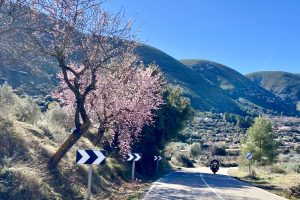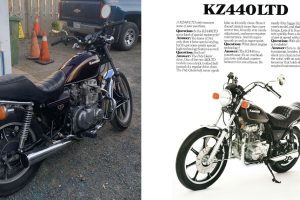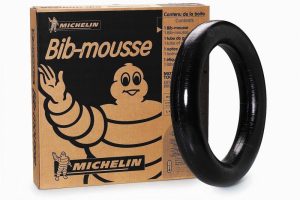Not too long ago, I wrote anextensive review on the Kyocera DuraForce Pro 2ruggedized phone. In the end, we were pleased with the phone’s performance and capabilities. But times change, and so does technology. Now, Kyocera is offering a more advanced 5G-capable phone they call theDuraForce Ultra 5G. And we received one to test with no restrictions. Well then, this should be fun!
In our review of the Kyocera DuraForce Pro 2, I came up with six unscientific tests that I hoped represented real-world ADV use. For the Kyocera DuraForce Ultra, I would run similar tests with some new and potentially catastrophic ones that should definitely challenge the phone’s ruggedization.
Test plan
Ultimately, my test plan would consider the environments and scenarios that adventure riders sometimes encounter. So what will happen during the test process? Here’s my two part, nine-point test plan:
Part 1
- Glove test – Is a rider able to make inputs on the display with a gloved hand?
- Speaker volume and sound quality test – Is the phone’s speaker loud enough to be heard with a closed full-face helmet or when moving on the trail? Is the sound clear?
- Screen brightness test – Since the phone would primarily be used outdoors, how well can you see the screen in bright sunlight?
Part 2
- Waterproofing test – This time, our waterproofing test of the phone would come in three different forms. A. Does the phone operate well while riding in the rain with all the ports closed? B. Can the phone charge and operate in the rain with a charging cable inserted into port? C. Can the phone survive in a simulated water crossing dunk?
- High heat environment test – Phones mounted on a motorcycle on a sunny and hot day receive a lot of heat. I’ve had other “high-quality phones” in the past that failed in significant heat. For this test, I will ride with the phone mounted towards the sun for hours at a time and on several 100°+ days.
- ADV/GPS software compatibility – Many riders use specialized apps to navigate and keep track of their position. I will run a few of these to test their compatibility with the DuraForce Ultra 5G.
- Drop test – Since phones mounted to bikes or carried by riders sometimes fall off or are dropped, could the phone withstand a drop from a motorcycle?
- Impact test – I will run over the phone placed on the surface of a dirt road with my motorcycle. The intent is to simulate what might happen to it should it fall off the bike and be run over by one of your trail riding buddies (by accident—or not).
- Phone camera – Test the camera for picture quality and whether it can also take a beating.
There’s a lot of testing to do, so let’s get started!
Phone specs
This is supposed to be a practical review of the phone’s capabilities in an ADV environment. So we’re not going to concentrate on the phone’s technical aspects. Below are Kyocera’s specs for the DuraForce Ultra 5G.

Specs for the Kyocera DuraForce Ultra 5G.
I note that this phone is larger and heavier than theDuraForce Pro 2 I reviewed in January 2021.
Gloved hand test
京瓷claims that the phone will accept inputs from a gloved hand. While the phone is designed for outdoor use by people who wear gloves in their day-to-day work, it’s not specifically designed for motorcyclists. And motorcycle riders often wear gloves that are bigger and thicker than many daily use work gloves.
Keeping that in mind, I donned an all-season pair of gloves that have dual chambers. I reasoned that putting the most material (leather and interior fabric together) between finger and phone would present the most difficult challenge for the phone in sensing my inputs.
From my test with the previous DuraForce Pro 2, I learned that the best way for the phone to sense a gloved hand touch was to use the pad of my finger, not the tip. Still, I decided to try both parts of my finger to see if there had been any changes to the phone’s touch-sensing capability.
It’s in the fingers
I tried using the tip of my finger without any luck, just like with the DuraForce Pro 2. But when I used the pad of my finger, the phone was able to sense my inputs. So while it was still a bit “fidgety” with the inputs, it was able to sense my touch when dialing the phone, creating text messages, and creating email messages.

Use the pads of your fingers to make an entry.
And from my perspective, having the inputs be a little fidgety is a small concession for not having to remove your gloves in cold, hot, or wet weather.
Since there is a bit of a trick to using the DuraForce Ultra 5G with your gloves on, I give it a C+ rating for this test. But not having to take your gloves off is terrific, especially in inclement weather.
Speaker volume test
让我们开门见山地说吧。外部扬声器on this phone is loud. It’s built to be used in noisy outdoor environments, and I’d say that Kyocera has accomplished its mission. It certainly can be heard. This phone has a very large and, importantly, a forward-facing speaker. So when it makes a sound, you will hear it. If you carry the phone and leave it anywhere near its louder volumes, you’ll probably end up turning down the volume.
With its forward-mounted speaker, sound is projected towards you, not in a direction where you aren’t. With the volume set to its maximum while on the bike, I could hear Google Maps directions up to about 35 mph. Better still, if you wear a modular, open-face, or dirt-bike helmet, you can probably hold a decent conversation with a caller using the phone’s push-to-talk feature.
Probably the best way I can tell you about how loud the phone is comes from an incident during testing. I was filming some low-mounted “action shots” with the phone in a RAM-X mount when it was pulled out of the mount by the deep grass I was riding through. It wasn’t until I got off the bike that I noticed that the phone was missing. So how did I find the phone in the tall grass? Simple, I called the phone and listened for the ringtone. I quickly found the otherwise completely lost phone. Nice!
Sound quality
I love to listen to music, and this phone has speakers that will let you hear it louder than others. But it is a phone, after all, so music through the speakers is what you’d expect from such a device. Listening to music through a helmet-mounted Cardo Packtalk Bold headset, the phone linked up quickly and easily.
When you are off the bike, the phone can connect by Bluetooth to your wireless headphones. If that’s out of the question, there’s still the good ol’ 3 mm jack for your wired headset. When all is said and done, the sound quality is up to par with other phones in the Ultra’s category.
And when in use as a phone itself, the sound quality is OK. Frankly, the sound quality through the external speaker seems a bit better than the speaker you put to your ear. But I’ve had no complaints from people on the other end of the line about sound quality when I call them.
The sound coming from the Ultra’s external speaker is loud and clear. And in comparison to other phones in its category, I give the Ultra an “A” for its volume and a “B” for its sound quality.
High temperature environment
One thing that can negatively affect a phone’s operation is a high-temperature environment. So heating up the phone was in the cards for the Ultra. Luckily, Kim and I had planned a round-trip ride across the USA from Vermont to Oregon and back during July and August. Surely, we’d hit some high temps along the way.
And the summer temperatures during the ride didn’t let us down. Daily temperatures were often in the high 90s and many days, well over 100 degrees. At one point, I saw 107 degrees on my T7’s outside temperature gauge. To make things even better for the test (but worse for me), there was little in the line of cloud cover for much of the journey.
The phone always worked. But there were times when the phone indicated that it was getting hot. Interestingly, the phone alerted me that it was and took steps to cool itself. During these times, the phone stopped charging. I don’t know what other (if any) steps the internals took to stay cool. But through it all, the phone continued to work well, and the GPS kept functioning. The Ultra 5G gets a “B+” here
Screen brightness
设计了d for outdoor use, the Ultra is supposed to be readable in bright sunlight. And I have to say that it is excellent in this regard. I tested it against a competitor’s phone, and it wins, hands down. To make things interesting, I decided to compare the phone against a well-known GPS which is designed for motorcycles and being used in bright sun. And I was pleasantly surprised to see that the Ultra’s display was nearly the equal of the purpose-built motorcycle GPS. So if you’re a rider who uses your phone to navigate, you shouldn’t have a problem reading the phone’s display. In case you are wondering, Kyocera says that the Ultra’s display is rated at 800nits.

This picture was taken in bright sunlight. As you can see, the phone’s display is nearly as bright and readable as the GPS, which is designed to be used outside.
That’s not to say that the phone is impervious to glare. I did not use any screen protector or protective case during testing. There can be some glare with the sun directly on the phone, but it is far less than other phones I have used in the past. In the end, I give the Ultra an “A” for its screen brightness and visibility.
Drop Testing
To test the DuraForce Ultra 5G, I decided to make the drop testing more hazardous than in my previous test of the DuraForce Pro 2. This time I would toss the phone onto a hardpacked dirt road complete with small loose stones on its surface. It makes the opportunity for the phone to be damaged and/or the screen broken much higher. And to make things even worse, I decided not just to drop the camera but to toss it up in the air before it came into contact with the ground.
视频中可以看到,我执行了几滴from 30, 40, and 50 mph. After taking hits of up to 6.1 Gs, the phone emerged unscathed except for a few minor scratches on the outside of the phone’s case. All of the phone’s glass (display and camera) remained intact and scratch free. As this drop test was a degree of magnitude more severe than the last Kyocera drop test, I give the Ultra an “A” rating.
Waterproofing test
This time around, I believe I’ve made the test for waterproofing tougher. I took some inputs from comments I received in the previous test and have incorporated some of them. For this test, the phone won’t sit in a sink to test its watertight capabilities. It’s going to ride in the rain and also do it while charging. And finally, it’s going to get a bath in the river while mounted on the bike.
So for the first test, I simply rode in the rain for a few hours on different days with all the ports closed. The phone worked flawlessly, and there were no alerts indicating water incursion of any kind.
Next, I did the same thing while charging the phone with a USB cable and an open charging port. The results were the same. The phone worked well, and there were no indications that water had entered the now open USB cable port at the bottom of the phone. Frankly, I was happily surprised that I could charge the phone on the go in the rain. For me, that is a big deal. We often ride long days while traveling in all kinds of weather, and knowing that I could continually charge the phone in the rain is a significant bonus.
ADV water testing
The last waterproofing test would complete my testing of the phone. While the previous Kyocera I tested was left in a sink for over half an hour with the camera running and completed the test with no failures of any kind, some people said that wasn’t a real-world test for adventure riders. So I had to think of something else.
To make the testing more relevant, I decided to test the phone in a water crossing situation. So I mounted the phone just above the bash plate using a RAM mounted “X” holder. The idea is to ride and walk the bike through river water and wholly or partially submerge the phone as I wade through the water crossing.
Nearby my home is the Ottauquechee River. It has slow sections and fast ones. Its depth runs from a few inches to several feet. Its bottom has sections of sand, pebbles, and large rocks, all loosely strewn. There’s no hard-covered bottom unless you are riding on top of a large boulder. With the phone mounted low on my T7, this test is a risky maneuver for not only the phone’s waterproof testing but also impact damage from rocks as I move through the river.
Ultimately, I had the phone either submerged or partially submerged in the water for more than 10 minutes. Immediately after exiting the water, I checked the phone, and it worked normally, and the speakers were still loud. So the Ultra gets an “A” for the water crossing test.
Impact Testing
Dropping a phone from a speeding bike is one thing, but can it take a weight-bearing impact? The scenario for this test is to simulate the phone falling off your bike and then being run over by one of your riding buddies or a car. Frankly, I felt pretty strongly that this test would be the end of the phone. But Kyocera had given it to me with no restrictions, and I think the scenario is a somewhat likely one. So ultimately, I’d chalk this test up to “destructive testing.”
I turned on the phone’s camera and prepared to have it record its demise. But the Kyocera DuraForce Ultra 5G bested my expectations. As the video shows, I ran over the phone at about 30 mph. And when I retrieved it, the phone still worked! You can see that the camera was still running after the phone flipped; it continued to record the sky above. That said, the display screen did crack near the top, but all of the phone’s capabilities remained intact.

This phone has been run over by a 450-pound motorcycle with a 200-pound rider, and the phone still works despite the cracks at the top of the display.
To say that I’m impressed that the phone survived this test is an understatement. And because of the phone’s ruggedness, it’s easy to give it an “A.”
Ghost touch problem, fixed.
About five weeks into our six-week trip, the phone started acting a bit funky. Suddenly, some of the app icons started jiggling and moving on the screen. Then some apps randomly started to turn on and off and Google Maps sometimes locked up.
I contacted Kyocera, and they sent me straight to their engineer for the DuraForce Ultra. We chatted for a while, and he said that it was possible that the phone may be having a “ghost touch” issue. The issue causes the phone to think someone is touching the phone’s screen. They had learned of this issue, and they were already working on a solution.
And, they asked me to send the original phone back to them for testing. Frankly, I am happy that they asked me to send it back. Kyocera QA wanted to evaluate the issue’s root cause and ensure they hadn’t missed anything in their fix. Having come from a military manufacturing environment, it’s nice to see that a company takes failure analysis seriously. They aren’t just setting issues aside and chalking them up to improper use by the user or random causes as a particular “fruit” phone maker has in the past.
I’ve been using the new phone for over a month now. And can report that the ghost touch issue is no more.
If you are wondering, all DuraForce Ultra phones manufactured after August 20, 2021, ship with updated software. For those that were manufactured before that date, the updated software is available as an over-the-air update.
GPS Software compatibility
There are lots of GPS apps out there. So many that some phone GPSs may not be able to run them. So it was essential to give a few of the better-known apps a try to ensure that the Ultra navigates with them without issue. And I can say that all of the apps I tested ran fine on the Ultra.
During our cross-country trip, I used Google Maps, Rever, and Waze with no issues at all. For apps using offline maps, I also tried Google Maps with offline maps, Maps.me, GAIA, and OsmAnd, and all of the GPS apps I tried ran without a problem; hence the Ultra gets an “A” grade for GPS software compatibility.
As for the GPS’s battery life, I got about 6 hours of use before I had to think about charging the phone. That said, you can charge the phone directly from your bike with a USB cable, even in the rain. So that makes GPS battery life a non-issue.
Camera quality and durability
判断手机的相机是非常主观的pic. So grading the camera without getting into technical details is quite difficult. That said, I can say that I think that the Ultra’s camera takes pictures as well as most others out there. If I have any complaints, it’s that when in camera mode, the display is very sensitive. You must be careful to avoid touching the screen anywhere near the mode settings, or you can inadvertently change the camera mode. Therefore, I give the camera a “B.”
Camera degradation caused by vibration
Recently, Apple notified the public that they should not mount their iPhones to motorcycles. Apparently, the vibration from the bike’s operation can degrade or destroy the camera’s performance over time. Since this is a current issue, I contacted Kyocera’s DuraForce Ultra engineer and asked him if this phone could suffer the same problem. He very strongly stated that it could not. Specifically, he wrote:
“This is NOT a problem for Ultra(engineer’s emphasis added). Apple is using Optical Image Stabilization (OIS) which is implemented in the camera lens itself, thus it is susceptible to damage by excessive vibration.”
“The DuraForce Ultra as a rugged device is designed specifically to withstand vibration, impacts, etc. This design intent utilizes Electronic Image Stabilization (EIS) implementing software stabilization algorithms that take information from the original video stream, metadata and gyro sensor data to dynamically minimize the effect of motion blur.”
In other words, the DuraForce Ultra’s stabilization is electronic. The iOS implements the stabilization in the camera lens. With Kyocera’s electronic solution to stabilization (vs. optical image stabilization), there’s no concern that vibration will cause the camera to fail. For ADV activities, that gives the Ultra a huge plus. The Ultra gets an “A+” when it comes to the camera’s ruggedness.
Pricing
The Kyocera DuraForce Ultra 5G is not cheap. But it does cost less than many other “top of the line” phones that can’t even come close to the Ultra’s ruggedization. The phone’s MSRP is $899.99. However, you can quickly find online offers that can reduce the price substantially. Or, if you are a Verizon business or government customer, there are “special deals.” For example, government customers can get the phone for “free,” and business customers can get $300 off the MSRP. Check Verizon’s website for details.
Conclusion
The Kyocera DuraForce Ultra 5G is a very rugged phone. And if you are tough on your phones, this one should be at the top of your list. It’s at the top of mine, and I may not wait for my Samsung S10+ to die. For ADV purposes, I like it that much.







